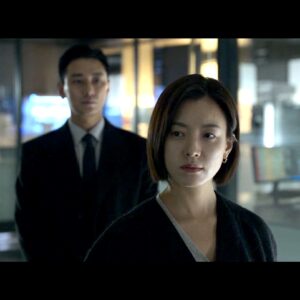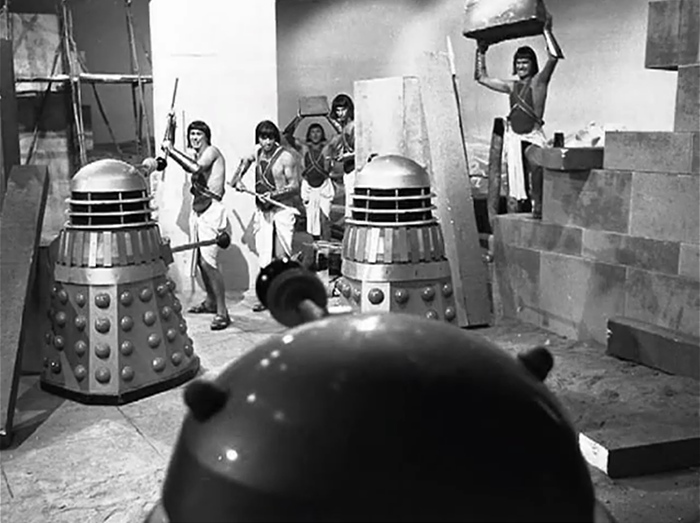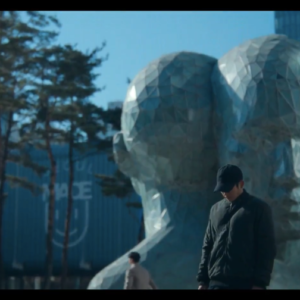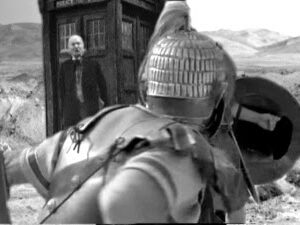We’re not free in what we do, because we’re not free in what we want

Warning: this post has spoilers for all of Dark, including the finale.
There’s a moment in Dark‘s final season. The moment where the plot spiralled in on itself to create such an indecipherable mess that you began to wonder how you could ever untangle it.
Seven timelines in a repeating self-contained time loop was brain melting enough. But seven timelines across two universes – especially when some characters jumped between the two – finally pushed even my paradox-loving brain to the limit.
As cognitively difficult as it was to watch the third and final season of Dark, the writer’s decision to create a Gordian knot of such complexity that I’m still not sure I have my head wrapped around it was a stroke of genius.

Jonas and Martha are both the beginning and end of their own stories in two seperate but enmeshed pocket universes. The end is the beginning but the loop is twisted, playing out not one but two iterations before it is complete. Like an Ouroboros in the shape of Infinity.
The Infinity symbol is what they use to designate the mysterious Unknown; the nexus point of the two universes and – we eventually learn – the name of the son of Jonas (from Adam’s universe) and Martha (from Eva’s universe).
The paradoxes this caused constitutes not just a single family line but the whole of reality for the small town of Winden.

Jonas and Martha essentially give birth to themselves in one giant Bootstrap Paradox encompassing the whole of their respective worlds.
Jonas, I found myself frantically calculating, was his own great great great grandfather. But Martha is his great great great grandmother as well as his Aunt. And of course he is Martha’s great great grandfather as well as being her Nephew. And since Silja was Jonas’ sister and she was the mother of his daughter-in-law then Jonas’ son fathered a child with his niece and…
My brain broke. So did everyone else’s.
This knot does not unravel, Dark said clearly. It has to be cut.
I’ve called this post an allegory of rebirth and that’s the theme I want to concentrate on but I could write an equally long missive on the notion of free will in Nietzsche’s eternal recurrence.
This seasons’ tagline We’re not free in what we do because we’re not free in what we want is an evocative statement. And like the ambiguity of most of Dark’s underpinning philosophy it could be seen as both a statement for and against free will. Free will in a universe of infinite possibilities, all of which have already happened, seems meaningless. Every action in Dark’s infinity-shaped time loop – just like every action in Nietzsche’s eternal recurrence – has already happened (even things you don’t think you’ve done yet).
All of Dark’s characters are driven to recreate the endless curving loop they’re stuck in, not because they want the cycle to continue but because they are pursuing what they desire. They cannot change what they do because the desire that underpins their struggle – what Schopenhauer would call his Will to Life (and from which Nietzsche drew his Will to Power) – does not change.
But want is not need. So if we were to change what we want then our actions will change. We are now a slave to that new desire but, if we have the ability to choose what we want, then free will could be seen to be possible.
Every character who time travels in Dark – but especially our Adam and Eva – end up needing the loop to exist for their desires to be met. While they say they want the loop to end, what they really mean is that they want the loop to stop – and at a time of their own choosing. A point that grants them the things they want – love, happiness, children, survival. Tears for Fears were right, it seems. Everybody does, in fact, want to rule the world.
But what if they decide what they truly want is for the loop to end?
Could it be possible for Jonas and Martha to choose to end the loop – even if it means the end of both their universes, worlds that ensure their existence in the first place?
Because while I could write two thousand words on Nietzsche, free will and the Bootstrap Paradox, Dark has a far more interesting theme to discuss and that theme is the destructive ravaging force that is grief.
Even as I write this post I am forced to pause for a moment. This is the third piece on grief I’ve written this year alone and for a moment I have to wonder if this is because of my own preoccupations or if the whole world really is grappling with grief in the same way as I am.
Is it just a case of selection bias that this year I’ve seen so many shows about grief, from the ethereal dreamlike A Piece of Your Mind to the beautiful and powerful Taiwanese drama Someday or One Day
Is 2020 also grieving? Or do I just seek out shows that speak to my own mood?
There is a lot to grieve in the world we live in today. Maybe it’s not just me.
To me, nothing so perfectly captures the zeitgeist of destruction, selfishness, narcissism and nihilism that humanity has wrought upon this Earth as Dark. And consequently very little else has offered up the kind of hope that the destruction we bring can lead to something better.
Earlier this year, Someday or One Day also used a time loop to offer the same metaphor of destruction and the same hope for the future. But whereas Taiwan did it using what Taiwan does best – a romance – Germany has done it using what it does best – existentialist philosophy.
At their core, both shows use a time loop to signify the destruction caused by the self-absorption of grief and both shows offer us the way out. But whereas Someday or One Day was interested in the impact of grief on one person’s small circle, Dark examines this on a larger social scale and in doing so completely captures the banality of human destructiveness.
Dark ambitiously takes on the cumulative effect of human frailties on the grand scale; examining how our individual selfishness in our pursuit of our personal desires can ultimately doom everyone. If there is a better examination of humanity’s greatest weakness then I don’t know what it is.
Man can do what he wills
But he cannot will what he wills
– Arthur Schopenhauer
Noah has to maintain the loop for his wife and daughter to exist. This is made doubly true because Charlotte, his daughter, gave birth to her own mother, his wife.
Understanding the source of the loop, Martha and Jonas are not just driven to ensure their own creation but that of their friends and families; Jonas’ journey being sparked from the beginning by the revelation his father was not Michael Kahnwald but in fact Mikkel Nielsen. Jonas’ father cannot be Jonas’ father if not for the loop and this is a fact he knows right from the start.
Or the end.
Either.
Or both.
Time loops are like that.
“We are all born of him,” Noah says to the middle-aged Martha as he looks at the family tree they’ve mapped out with the Infinity symbol sitting in the nexus point. “You gave life to him. And he will give us ours.”
For these people to exist, the Unknown needs to exist. The loop is the result of his creation and his creation requires the loop.
Nobody in Dark set out to destroy the world. Nobody in Dark wanted to be the villain. Nobody in Dark was evil. The things they wanted were the things we all want: to live, to feel loved and respected, for our loved ones to survive, and for our children to grow up healthy and happy.
Dark’s series tagline – Everything is Connected – is literally true. But it’s figuratively true as well. Every single character in the show, even the ones who seem almost Godlike in their manipulation and cruelty, are merely small and myopic beings trying to recapture or replace something they lost. They’re all connected by their motivations: to reclaim the past, even if it’s at the expense of others.
They are, every one of them, lost to grief.
“Everything repeats itself again and again for all eternity,” says Eva to Jonas as she deliberately pokes and prods at the core of his secret and illicit need – his love and desire for Martha, who he now knows is his Aunt. “Because none of us is prepared to let go.”
“You and I, we’re the reason all of this happens time and time again. Because you can’t let go of what you want and I can’t let go of what I want. But we are the glitch, the glitch in the matrix.”
– Jonas
Of course Eva is being manipulative here, motivating Jonas to “let go” of his love for the Martha from his universe and transfer it to the Martha from the enmeshed second universe. And yet, like much of the machinations and manipulations practiced by Adam and Eva to maintain the cycle they’re stuck in, the statements are also inherently true.
Everything repeats because we can never let go of our desires. We want, therefore we act. The only way out is to stop. For that we need to let go. The knot cannot be untied, it needs to be cut.

There are few things in the world of storytelling so powerful and so beautiful and so deeply stunningly tragic than Martha and Jonas’ decision, finally, to end the loop. Knowing they are sacrificing everything they have strived to attain, retain or regain. There is no end to the endless torment and torture of their worlds and so they choose to end them.
But this is not a suicide born of self-absorption or of nihilism. If anything, the nihilists are those stuck in the brutal cycle of destruction, pain and violence that the time loop represents. Those that would allow an apocalyptic accident to destroy everything just to create the technology they need to meet their own selfish desires: the disfigured Adam that Jonas would become and the scarred Eva that would result from Martha.
The two the equal and opposite of the other, reaching across a dark chasm of spacetime in an inevitable quest that becomes, quietly and slowly like a creeping blackness, a quest only for their own survival and the perpetuation of the status quo.

Jonas desires Martha, Adam is driven to kill her knowing his anger and grief over her death is the motivation he needs to perpetuate a cycle that will lead him back to her. And in the second universe, Martha and Eva play out the same cycle and for the same reasons until Adam eventually kills Eva, a death that finally turns Martha against him.
Adam kills Martha and Eva kills Jonas.
Adam and Eva are born from their grief.

But Jonas’ and Martha’s decision to sacrifice themselves to save us all is not a decision they come to alone. They are prompted by Claudia – the brilliant, persistent and aggressively non-conformist Claudia – who has been working secretly to understand the loop while others have simply been acting in pursuit of their own desires.
Not that Claudia is free of the same motivations as everyone else. She first must ensure that her own daughter, Regina, will still exist if the loop is broken. Once she is assured of this, she works tirelessly to find the point at which time was broken. If these are two enmeshed pocket universes then there must be a point at which they diverged from their parent universe.

The origin Universe – our universe if you will – had an ordinary but brilliant man named H.G. Tannhaus. After a bad fight on a stormy night, his son who was visiting with his wife and newborn decided to leave early and had a terrible accident.
The loss of his son, daughter-in-law and grandchild drove Tannhaus mad with grief and he tried to build a time machine to bring them back to life. The temporal disaster he sparked created two universes, each ballooning out from the parent universe like petals of a dark flower and looping back to their own beginning.
Claudia realises this moment is a nexus point of all three worlds and, if they could travel back and change that moment, then the knot wouldn’t just be broken – it would cease to exist, taking everyone whose existence relied on it with them.

It is no surprise that Tannhaus’ pain and grief gives birth to a world – two worlds – of pain and grief. Worlds of darkness where his own life of loss and desperation is played out again and again with the lives of people within them. Tannhaus cared only for his own grief and his own desires more than he cared for the world he lived in. It is no wonder his experiments led only to disaster.
Jonas and Martha have a choice here, it’s important to stress. A true choice. A choice that comes from knowledge of the universe, a choice that comes from the ability to listen to those who have no vested interest in the maintenance of the status quo.
This choice is a difficult choice. A true sacrifice.
They sacrifice everything they’ve ever known and ever loved. They sacrifice the comfort of the familiar, even if that familiar is an unfolding horror show. They sacrifice each other. They sacrifice their child. They sacrifice themselves.
Their desires, their wants, their will to life, their will to power is ultimately less important to them than the wellbeing of the world they live in. They sacrifice themselves: not for their loved ones, for their descendants, for their children or their relatives, not even for people they know.
They do it to make the world better generally for everybody, even for people they don’t know and will never know. They are willing not just to sacrifice their lives but their very existence for the greater good.
“The end is the beginning,” Adam says as he sends his younger self, with Martha, off to save Tannhaus’ family and remove his grief-stricken impetus to invent time travel.
And for the first time, the cliche becomes fresh, becomes powerful and even profound. Because their end truly is the beginning for once. Not just the start of a new endless grinding cycle of selfishness, narcissism, nihilism and death.
A new beginning, a fresh start. A world that starts with an act of compassion and salvation, not an act of desperate uncaring grief. Three worlds merge and only one lives on. This one built on a selfless act borne of love. The same love that once destroyed the world but now saves it.
And this, ultimately, is why Dark’s ending is so powerful, so uplifting and so transcendentally beautiful. Because it says that we do have free will, we do have a choice. And that choice can lead us into the light and not into the darkness.
As Martha and Jonas disintegrate, it becomes not a tragedy but a moment of true connection and commitment between the two. As Adam and Eva disintegrate, it becomes a liberating moment of finally, peacefully letting go.
The world may feel like it’s ending.
But this ending can be a beginning.
It may take sacrifice but it’s our sacrifice to choose.
We too can rebirth a world worth living in.





Both my wife and I watched the first season of Dark when it first came out. It was certainly compelling viewing and something that did excite my “little grey cells.” I have yet to come back to it for the remaining seasons. Time travel and its paradox is often a discussion in our house including whether meeting yourself will cause time to alter and sending information back through time re the bootstrap paradox (both concepts explored with great relish in Fringe), the power needed to bend space to create a doorway though a common point and whether Doctor Who is now worth the effort.
I have enjoyed your other comments re Nietzsche, so much so, I hard to track down his comments on food and diet. Two things that jumped out at me were his “feelings” re its better to be away from Germany than in it, and hot chocolate was very worthwhile, and of course he enjoyed Italian food.
To be selfless is beyond noble, it is divine, and I think I am going to have to watch the remaining seasons of Dark to test your delightful observations!
Sean! It’s always nice to see you round the blog. Thanks for taking the time to comment.
I seem to be writing about Nietzsche a lot lately, although hopefully I’m done for a while. Still, “Yes to Italian food and hot chocolate and no to Germany?” Who knew I’d agree with Nietzsche on something…
The long break between Season 1 and Season 2 of Dark (a full 18 months) means some people who enjoyed the first season forgot its existence, I think. Of course the break was necessary for them to align the seasons with the main dates in the series and the final season was released on Netflix on the apocalypse, June 27th, 2020.
I certainly hope you get around to watch the next two seasons, although I highly recommend starting season 1 over again before you do. This show is so incredibly detailed it makes my brain ache. But it’s intricacies are what make it so brilliant. That and it still managed to have a strong emotional core. Definitely one of my all-time favourites.